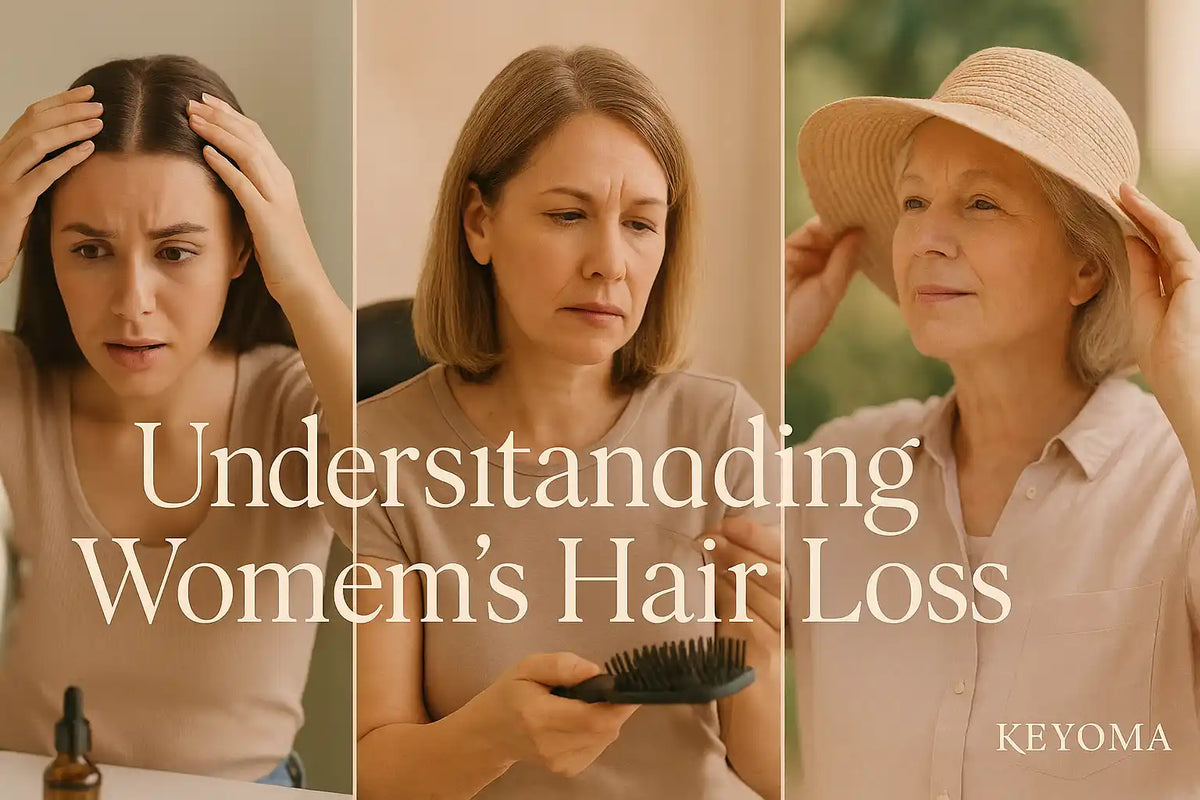In this article
We often hear about men losing hair, but you and I know it affects women too—and more often than people think. Around 40% of women see visible hair thinning by the time they turn 50, though it can begin much earlier.
When our hair starts thinning, it doesn’t always follow the same pattern as men. Instead of a bald spot or receding line, you might see your part spreading wider or notice your ponytail feels much thinner than it used to.
How Hair Grows, Falls, and Regrows
Our hair grows in repeating cycles, so new strands usually come in to take the place of the ones we naturally shed. You and I go through three main stages in this growth process:
- About 90% of the hair on our heads stays in the anagen phase—the active growth stage. This period can last anywhere from 2 to 8 years.
- Next comes the catagen phase. During this short transition phase, which lasts 2 to 3 weeks, your hair follicles shrink and stop producing new growth.
- Then we move into the telogen phase. This resting stage lasts 2 to 4 months. After that, those strands naturally shed to make way for new ones.
Finding strands in your hairbrush or shower drain doesn’t always mean something’s wrong. We normally shed 50 to 100 hairs a day.
But if you notice more hair falling out than usual or see visible thinning, it’s time to check in with your doctor. You’ll get answers faster and figure out what’s behind the change.
Why Hair Loss Happens in Your 20s and 30s

Most of us don’t anticipate hair loss in our 20s or 30s. But when it starts early, there’s often a clear reason—and you can usually reverse it.
Stress, restrictive diets, and shifting hormone levels are the top triggers for thinning hair in younger women. In rare cases, autoimmune conditions can also cause your hair to shed.
1. Stress
Stressful experiences often trigger hair thinning in women. Illness, job loss, a breakup, or giving birth can all push your body into “survival mode,” where it conserves energy for the most essential functions.
When you're under pressure, your body shifts hairs from the growing phase into the resting phase. These strands eventually fall out—a process known as telogen effluvium.
With telogen effluvium, you may notice increased shedding about 3 months after the stressful event. This can continue for 3 to 6 months. Although the hair loss might feel rapid, it won’t cause complete baldness. Once the stress lifts, your hair usually starts to regrow within several months. Full recovery can take 12 to 18 months, depending on your hair’s length.
2. Dieting
Extreme dieting can harm your hair in two ways. When you lose weight too quickly, your body sees it as a threat—like you're starving. At the same time, you may not get enough nutrients to support healthy hair growth.
During stress or nutrient shortages, your body often cuts off support for hair first. You might start shedding more than usual. In many cases, your hair grows back once your body recovers. But if you stay on a restrictive diet and lack key nutrients like protein or vitamins, your hair may struggle to regrow.
Poor nutrition can also affect how your hair looks. You might notice strands turning dry, dull, or brittle. If you're losing hair and following a strict diet, it's time to reassess your approach and focus on nourishment.
3. Hormonal Changes and Imbalances
Hormone shifts can influence how our hair grows. When your estrogen levels rise, your strands often feel thicker and more voluminous. But when estrogen drops—like after childbirth, during menopause, or when you stop taking birth control—you might notice more shedding. Your hair usually stabilizes once your body adapts to these changes.
While estrogen supports hair strength, progesterone may do the opposite. This hormone can trigger or worsen hair thinning in some people. Certain birth control pills that rely on progesterone have been linked to noticeable hair loss. If you’re seeing changes, it’s worth reviewing your birth control options with a healthcare provider.
- Hormonal implants like Nexplanon
- Birth control injections such as Depo-Provera (medroxyprogesterone)
- Skin patches like Xulane (norelgestromin and ethinyl estradiol)
- Vaginal rings like NuvaRing (etonogestrel and ethinyl estradiol)
When our hormones shift out of balance, we face a greater chance of losing hair. Conditions like hypothyroidism, polycystic ovary syndrome (PCOS), and congenital adrenal hyperplasia often trigger these shifts.
Your doctor may suggest checking your hormone levels if you notice hair thinning along with other symptoms like:
- Feeling too hot or cold when others feel comfortable
- Extra hair growing on your face or body
- Trouble managing weight, whether gaining or losing
- Breakouts caused by shifting hormone levels
- Menstrual cycles that come late, early, or skip altogether
If your hair thinning started after using progesterone-based birth control, stopping it should help your strands recover. If a hormone imbalance caused the shedding, you’ll need to find and fix that imbalance before your hair can grow back.
4. Pregnancy
Your hormones shift during and after pregnancy, and these changes can affect how much hair you lose. Many of us enjoy fuller, thicker hair while pregnant because rising estrogen levels keep more strands in the resting stage.
After giving birth, your estrogen levels fall. This drop can lead to noticeable shedding, usually peaking around 3 to 4 months postpartum. But this phase won’t last forever. Most of us regain our usual hair volume within a year.
5. Autoimmune Conditions
Our hair can thin or fall out when the immune system mistakenly attacks the hair follicles, though this cause is less common. When this happens, your body treats hair as a threat and forces it to shed.
Autoimmune conditions that can lead to hair loss in younger women include:
- Systemic lupus erythematosus: Lupus can trigger overall hair thinning or patchy hair loss with scarring. Getting diagnosed and starting treatment early helps you avoid lasting damage.
- Alopecia areata: In this condition, your immune system targets your hair follicles. You might see a round bald spot, usually on your scalp, but it can show up anywhere on your body. Hair might grow back without treatment, but the bald areas often return unexpectedly.
Hair Loss in Your 40s and 50s

You may notice more hair loss in your 40s and 50s. For many of us, this comes from inherited traits. Menopause can make thinning more noticeable. On top of that, how we’ve treated our hair over the years—like frequent heat styling or chemical treatments—can start to show during this stage of life.
1. Hair styling
Traction alopecia happens when we put repeated strain on our hair. If you're noticing thinning now, it might trace back to how you styled your hair in your 20s or 30s. Some of us also experience faster, more dramatic hair loss after harsh chemical treatments that irritate or burn the scalp.
Using relaxers or hot combs can trigger inflammation. Tight hairstyles like braids, weaves, or ponytails pull on the roots and weaken the follicles. Over time, this stress can scar the scalp and cause permanent shedding. You might first spot this kind of damage as thinning near your edges or hair loss on the crown.
2. Genetics or Female-Pattern Hair Loss (FPHL)
Genetics causes most cases of hair loss in both men and women. You can inherit hair thinning from either parent. Female-pattern baldness (androgenetic alopecia) often begins after age 40. Around 40% of women notice thinning by 50. Fewer than half of all women keep a full head of hair throughout life.
Hereditary hair loss doesn’t always look the same in women. You might see your part widen or your hairline move back. For most of us, the thinning progresses slowly but can eventually affect the whole scalp if left untreated.
Women often lose less hair than men, but we feel the impact more. Many of us avoid social situations or feel less confident because of it. The good news—starting treatment early helps slow, and in some cases reverse, the thinning.
3. Menopause
When you reach menopause, your estrogen levels drop sharply. This shift causes your hair to thin, especially along the top and sides of your scalp, and it grows at a slower rate. Some of us also start to notice more facial hair during this time. If hereditary hair thinning runs in your family, menopause can make it more noticeable.
Another reason you might lose hair after menopause is postmenopausal frontal fibrosing alopecia. This condition causes inflammation that damages your hair follicles and leads to scarring. It usually affects the hairline and eyebrows. Early diagnosis is critical—once scarring sets in, your hair can’t grow back.
Hair Loss After 60: What to Expect

As we grow older, our hair naturally grows slower and takes longer to renew. Health issues can also weaken your strands, and some medicines you take might lead to thinning or shedding.
1. Aging
By your 60s, your hair starts to show signs of aging—just like your skin. Strands turn gray or white, become finer, and grow back more slowly after shedding. Instead of thinning only at the part or hairline like hereditary loss, age-related shedding happens across your entire scalp.
Sun exposure can speed up this process. Pigment helps protect your hair, and once strands lose their color, they become more sensitive to UV rays. You can shield your hair by wearing hats and using hair products with built-in sun protection.
2. Health problems
Health issues can trigger or worsen hair shedding. Conditions like hypothyroidism, anemia, and lack of key nutrients—especially as we grow older—can weaken our hair and slow regrowth.
Cancer and its treatments also impact our hair. Chemotherapy and radiation harm active follicles, often causing sudden shedding known as anagen effluvium. The good news: most of us will see regrowth about a year after finishing treatment, although the new strands might come back lighter, grayer, or whiter.
3. Medications
As we get older, many of us start using more prescription drugs. Some of these treatments can lead to hair thinning or shedding. If you think your medication affects your hair, talk to your doctor. They can check your options and help you switch to something else if needed.
Here are some common medications linked to hair loss:
- Antidepressants like bupropion (Wellbutrin) and SSRIs such as fluoxetine (Prozac), paroxetine (Paxil), and sertraline (Zoloft)
- Blood thinners including heparin, warfarin (Coumadin), and apixaban (Eliquis)
- Beta blockers for high blood pressure, like propranolol (Inderal), metoprolol (Lopressor, Toprol), and atenolol (Tenormin)
- Anti-seizure drugs such as valproic acid (Depakote), pregabalin (Lyrica), and levetiracetam (Keppra)
Control Hair Loss at Any Age With Keyoma
As women, we deal with hair loss for many reasons—and those reasons often change as we age. If you start seeing more shedding, thinning areas, or bald spots, connect with a dermatologist early to pinpoint the cause and explore solutions.
We can also take steps ourselves. Eating nutrient-rich foods, reducing stress, and avoiding harsh treatments all help protect your hair. And if you’re looking for a proven way to nourish your scalp, try Keyoma Batana Oil. Its natural benefits support healthier growth and help restore fullness—starting from the roots.
Featured Product
100% Pure Batana Oil + Rosemary









